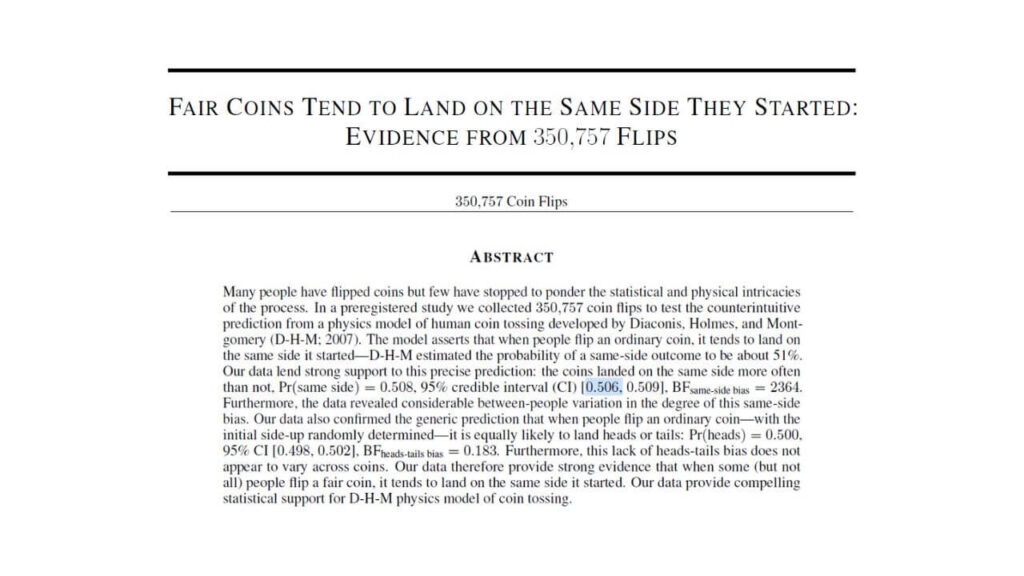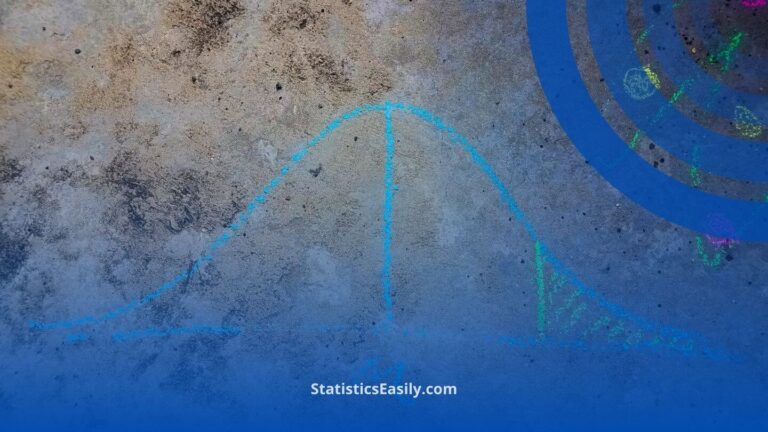Think Coin Flips Are 50/50? This Study Will Make You Think Again
You will learn the surprising truth behind coin flips and their unexpected statistical bias.
Introduction
The common belief in coin flips as a symbol of pure chance is deeply ingrained in our collective mindset. Historically, even the most eminent mathematicians have harbored doubts about the absolute impartiality of a coin flip. Recent investigations, driven by the quest for empirical truth, have taken on the formidable task of examining this age-old assumption through a rigorous scientific lens. This groundbreaking study illuminates the nuanced biases inherent in coin flips. It challenges us to reconsider our understanding of randomness and determinism in the phenomena that pervade our daily lives.
Highlights
- Coin flips show a slight bias towards the initial face-up.
- A new study reveals coin flips aren’t perfectly 50/50.
- Statistical evidence challenges the randomness of coin flips.
- Same-side bias in coin flips confirmed by extensive data.
- Practical implications of coin flip biases explored.
Ad Title
Ad description. Lorem ipsum dolor sit amet, consectetur adipiscing elit.
Background
Historical analyses of coin flips have often hinted at underlying biases, a topic that has intrigued mathematicians for centuries. Despite numerous studies attempting to quantify this bias, conclusive evidence remained elusive due to the limitations of these early experiments. The theoretical groundwork laid by Diaconis, Holmes, and Montgomery (D-H-M) marked a pivotal turn, suggesting a subtle yet persistent same-side bias in coin tosses. This framework provided a statistical basis for further empirical investigation, aiming to dissect the intricacies of this phenomenon with unprecedented precision.

Methodology
The methodology of this study was meticulously designed to ensure the robustness and applicability of its findings. Data were amassed in three distinct environments, adhering to a uniform protocol to guarantee consistency across all data points. Initially, a quintet of bachelor’s degree students embarked on an ambitious project, each committing to collect at least 15,000 coin flips. This collective endeavor contributed a substantial 75,036 flips to the study’s dataset.
In pursuit of a more comprehensive dataset, the research team orchestrated a series of intensive “coin-flipping marathons.” These events saw 35 participants engage in up to 12 hours of continuous flipping, a testament to their dedication and rigorous study demands. These marathons significantly bolstered the dataset, adding an impressive 203,440 flips.
Further broadening the study’s scope, an open call for collaboration was extended via social media platforms, such as Twitter, inviting the global community to contribute. This innovative approach welcomed seven additional contributors who added 72,281 flips to the dataset. This diversified data collection method ensured a vast quantity of data. It introduced various flipping techniques and environmental factors, enriching the study’s analytical depth.
The diversity of the coins used, encompassing different currencies and denominations, was a critical aspect of the study. This variety was intentional, aimed at ensuring the findings’ broad applicability across different physical characteristics of coins, thereby enhancing the universality of the study’s conclusions.
Findings
The investigation into the phenomenon of coin flips has yielded a subtle yet significant discovery: a marginal preference for coins to land on the same side they were launched from. This finding, quantified as a same-side bias with a posterior probability of 0.5060, falls within a 95% confidence interval of 0.5031 to 0.5089, even after excluding potential outliers. Such results underscore the consistency of this bias across numerous trials and harmonize with the theoretical predictions of the Diaconis-Holmes-Montgomery (D-H-M) model, which anticipated a near 51% inclination towards the same-side outcome.
The study’s findings challenge the conventional wisdom of a 50/50 heads-tails split in coin flips, suggesting an inherent bias influenced by the coin’s initial position. This revelation is further supported by the lack of significant variance in heads-tails outcomes (posterior probability of heads at 0.5008, within a 95% confidence interval of 0.4988 to 0.5031), reinforcing the hypothesis that the initial state of the coin plays a pivotal role in its eventual resting position.
Moreover, the analysis presented moderate evidence against heterogeneity in heads-tails bias among different coins. A substantial Bayesian Factor supports the persistence of same-side bias and between-people heterogeneity in this bias, suggesting that individual flipping dynamics may also contribute to the observed outcomes. These findings invite a deeper exploration into the mechanics of coin flips, challenging the traditional understanding of randomness and probability in seemingly simple systems.

Implications
The nuanced findings from this comprehensive study of coin flip carry implications beyond academic curiosity into everyday decision-making. Despite the revelation of a slight bias towards a coin landing on the same side, it was flipped from, the practical impact of this bias on most coin-toss decisions is minimal. The study’s results, indicating a same-side bias with a hierarchical mean estimate of approximately 0.508, affirm the theoretical underpinnings posited by the Diaconis-Holmes-Montgomery (D-H-M) model but also underscore the subtlety of this bias in practical scenarios.
For instances demanding absolute fairness, where even the slightest bias could tip the scales, several mitigating strategies can be employed. One straightforward method is to obscure the coin’s initial position before the toss, thus negating the advantage conferred by knowing the starting side. Alternatively, employing a third party to execute the toss or using a mechanical coin flipper could ensure impartiality by removing human influence from the flipping process.
Moreover, the study’s insights into the variability of same-side bias among individuals highlight the importance of considering the flipper’s technique in scenarios where coin tosses are used to make significant decisions. This variability suggests that some individuals might inadvertently introduce a greater degree of bias based on their unique flipping dynamics, further complicating the assumption of a 50/50 outcome in coin tosses.
In conclusion, while the inherent bias in coin flips revealed by this study is statistically significant, its effect on everyday decisions is likely negligible for most purposes. However, in situations where absolute impartiality is paramount, the findings advocate for measures to neutralize potential biases, thereby preserving the integrity of the coin toss as a tool for decision-making.
Reflections
This comprehensive study has explored coin flips, illuminated an understated complexity within a phenomenon often relegated to simple chance. Identifying a slight bias towards the initial side of a coin flip challenges traditional perceptions of randomness. It injects a nuanced layer of determinism into what many consider the epitome of a random event. This subtle deviation from expected outcomes enriches our understanding of physical and statistical principles and invites a reevaluation of randomness in everyday occurrences.
The findings encourage a broader contemplation on the interplay between randomness and determinism, extending beyond the confines of coin flips. They prompt us to question the underlying mechanics of other phenomena typically classified as random, urging a deeper investigation into the factors that subtly influence outcomes in ways standard models might not fully account for.
Further research in this domain is not merely an academic pursuit but a quest to refine our understanding of the world’s unpredictability. By delving into the intricacies of seemingly random events, we can uncover the layers of order and predictability that lie beneath, offering insights that could have implications across various disciplines, from physics and mathematics to philosophy and decision theory.
This study’s revelations beckon us to expand our inquiry, challenge assumptions, and embrace the complexity of the world’s phenomena with renewed curiosity and rigor. The nuanced understanding of coin flips serves as a metaphor for the broader scientific endeavor: a reminder that within every element of chance, a thread of predictability may lie waiting to be unraveled.
Ad Title
Ad description. Lorem ipsum dolor sit amet, consectetur adipiscing elit.
Conclusion
The comprehensive analysis of 350,757 coin flips has provided compelling empirical support for the Diaconis-Holmes-Montgomery (D-H-M) model’s nuanced prediction: coins frequently land on the same side they were initially flipped from. This research validates the model’s assertion of a slight same-side bias. It highlights the significant variability in this bias among individuals. Such variability suggests that factors like the flipper’s technique might influence the outcome, thereby introducing an element of predictability into what is traditionally considered a purely random process.
The study meticulously addressed data integrity by videotaping and auditing the flipping process, minimizing potential biases. However, the participant’s awareness of the study’s hypothesis raises concerns about the possibility of unconscious influence on the flipping outcome. This factor warrants further investigation to ensure the robustness of the findings.
Interestingly, the practical implications of this slight bias are more theoretical than impactful for everyday coin toss decisions. Yet, understanding and mitigating this bias becomes essential in scenarios where absolute fairness is crucial, as demonstrated by a hypothetical betting scenario. This scenario revealed that even a minimal bias could lead to significant gains over numerous bets, underscoring the importance of concealing the coin’s starting position in high-stakes decisions to maintain fairness.
This study’s revelations invite us to reconsider our understanding of randomness and challenge the assumption that coin tosses are the epitome of unpredictability. The findings encourage further exploration into the deterministic elements of seemingly random events, paving the way for future research to delve deeper into the physics and psychology behind coin flipping and similar phenomena.
Recommended Articles
Dive deeper into the world of statistical anomalies and uncover more insights by exploring related articles on our blog.
- Understanding Random Sampling: Essential Techniques in Data Analysis
- How Statistics Can Change Your Life: A Guide for Beginners
- 7 Myths About Statistics You Need to Stop Believing
- 5 Statistics Case Studies That Will Blow Your Mind
- Random Sampling on Excel: An In-depth Analysis
Frequently Asked Questions (FAQs)
Q1: Is a coin flip actually 50/50? Contrary to common belief, a coin flip is not ideally 50/50 due to slight biases in the flipping process.
Q2: What happens if you flip a coin 1,000,000 times? Flipping a coin often highlights small biases, showing a deviation from the expected 50/50 outcome.
Q3: Why is a coin flip 49/51? The slight bias in coin flips, often leaning towards the side facing up when flipped, can result in a distribution close to 49/51 rather than 50/50.
Q4: What is coin flips? Coin flips are commonly used to illustrate random chance. However, studies show they may have a slightly predictable bias based on initial conditions.
Q5: How was the coin flip study conducted? The study involved over 350,000 volunteer flips, revealing a slight bias towards landing on the same side it started.
Q6: Can the bias in coin flips affect decisions? While the bias in coin flips is minimal, knowing it can provide a slight advantage in decision-making processes that rely on them.
Q7: How can I ensure a fair coin toss? To minimize bias, conceal the coin’s initial position or use an alternative method that doesn’t rely on flipping.
Q8: Do different coins show different biases? The study found the bias consistent across various coins, suggesting the phenomenon is not coin-specific.
Q9: What implications does this have for probability theory? The findings add nuance to our understanding of probability, indicating that seemingly random events can have predictable elements.
Q10: Will further research be conducted on coin flips? The intriguing results encourage further investigation into the subtleties of coin flipping and other random phenomena.








